The Memorial Chapel room was built as part of the third addition to the Parish House. The room was set aside as a Memorial Chapel to be used as a quiet place, reading, meditation and prayer. However it has become necessary to use the room for many other purposes, e.g. instruction for new member groups, rehearsals for both the senior and junior choirs, and Bible classes.
Memorials: The blue cross on the wall in front of the room is in memory of Mrs. Lillian Gemmill, who died in 1961. The cross is given by her family, who were not members of the church but friends of our pastor, Rev. George N. Barford.
The library was established in memory of Miss Minnie E. Waite, who died in 1959. She was a librarian for many years and, with her sister Mary Louise, became a member of the church on coming to Yorktown. Miss Minnie Waite was later chosen to be an elder.
The ceramic sculpture is in memory of Mrs. Barbara Briegs Barford, the first wife of Rev. Barford. The sculpture was executed by Mrs. Nellie Dodd Speers, a talented sculptress and a member of the church.
The furniture, except the metal chairs, was purchased with funds given in memory of Arthur C. Lee, Jr. who died after an operation in April 1961.
In the Church building, there are many articles purchased and given as memorials. Notable among them is the bronze tablet on the rear wall of the sanctuary. It was given by members and friends of Rev. William James Cumming, pastor for 30 years, 1876-1906. The candelabra were given by the George Groht family in memory of Mrs. Groht’s papents. The piano was purchased from funds given in memory of John F. Wilkens, Jr. There are other memorials as well.
P.S. This was posted on the wall in the Chapel (music room) by Arthur Lee before the addition in 1997. Read the history board.
An excerpt from a sermon by Rev. William J. Cumming on August 6, 1876. He was the congregation’s 10th pastor, serving from 1876 to 1906.
This church antedates the Declaration of Independence by nearly half a century. When it was organized, no one then thought of a separation from the mother-country, nor had it then entered into the minds of even of the most visionary the astounding changes a century would make.
At this time, the population of this entire county, outside of a few of the large towns in the south-east corner, was not more than one-fourth of that of Peekskill today. The country was sparsely settles. Many, perhaps most, of these hills were covered with forests. These roads were but bri-dle-paths. The saddle, whish has since been superseded by the wagon, was then in vogue. The main road was called the “King’s Highway”, and what is now known as Crompond Street was styled “Kingston Street”.
Then there was but one Synod in the entire American Presbyterian Church, while now they number thirty-seven; and four Presbyteries, while now there are 175 in the northern church alone. The General Assembly, with which we have become familiar by its annual sessions, did not exist until sixty years later. The Yorktown Church has passed through all the periods of both church and state. It was born in colonial times, it passed through the fiery trial of the Revolution, and has remained to witness and rejoice in the one hundredth anniversary of our national birth.
It lived under royal governors, and it enjoyed the beneficent rule of the republic. It began its existence when the divine right of kings was an established dogma, and it has lived to see accepted in profession, even by the tyrannical Sultan of Turkey, the fundamental principle of our national government, that rulers derive their authority from the consent of the people.
It was born in the slow-coach days of the sailing vessel and the saddle, and it has seen these give way to the wagon, the steamer and the railroad. At its birth there was going on in the American Presbyterian Church a conflict between Old and New sides, which culminated in the Division of 1741.
Submitted by Dick Hunter, Church Historian
